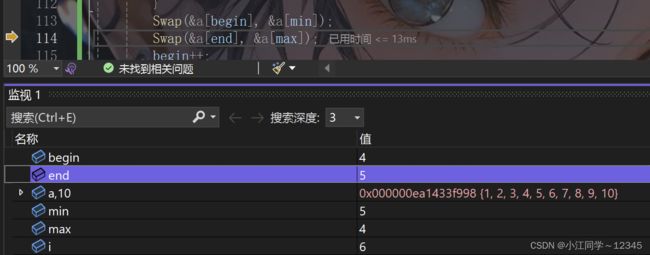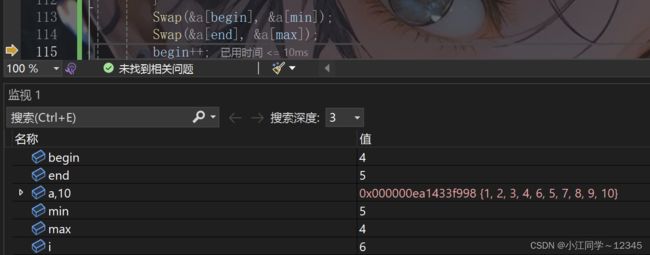元旦特辑:Note6---选择排序
目录
前言❌
1. 基本思想⚠️
2. 直接选择排序
2.1 思路分析✳️
2.2 代码实现❎
2.2.1 sort.h
2.2.2 sort.c
2.2.3 test.c
2.3 问题解决❇️
2.3.1 sort.c修改
2.4 特性总结✅
3. 堆排序
3.1 代码实现
3.2 特性总结
4. 选择排序和插入排序性能对比️
后语⭕️
前言❌
Hey young fella! Welcome to my channel! 前面一篇博客,我们学习了插入排序的2种实现方法。今天也是类似的,今天我们将一起学习选择排序的2种实现:直接选择排序+堆排序。
1. 基本思想⚠️
每一次从待排序的数据元素中选出最小(或最大)的一个元素,存放在序列的起始位置,直到全部待排序的数据元素排完 。
2. 直接选择排序
2.1 思路分析✳️
目标:实现升序
思路:暴力选取
把数据遍历一遍,依次将最大(小)的,次大(小)的,次次大(小)的放到对应的前三位(每次选取都要遍历一遍),然后重复上述步骤,直到最后就剩下1个数据
当然,我们也可以优化一下:
第一次遍历选出最大的和最小的放到头和尾的位置
第二次遍历选出次大的和次小的放到头+1和尾-1的位置
......
2.2 代码实现❎
2.2.1 sort.h
#pragma once
#include
#include
//打印
void PrintArray(int* a, int n);
//直接插入排序
void SelectSort(int* a, int n); 2.2.2 sort.c
#include"sort.h"
//打印
void PrintArray(int* a, int n)
{
for (int i = 0; i < n; i++)
printf("%d ", a[i]);
printf("\n");
}
//交换
void Swap(int* p1, int* p2)
{
int tmp = *p1;
*p1 = *p2;
*p2 = tmp;
}
//直接插入排序
void SelectSort(int* a, int n)
{
int begin = 0, end = n - 1,i;
while (begin < end)
{
int min = begin, max = begin;
//一次排2个min和max
for (i = begin + 1; i <=end; i++)
{
if (a[i] < a[min])
min = i;
if (a[i] > a[max])
max = i;
}
Swap(&a[begin], &a[min]);
Swap(&a[end], &a[max]);
begin++;
end--;
}
}2.2.3 test.c
#include"sort.h"
//直接插入排序
void testSelectSort()
{
int a[] = { 3,2,6,8,9,7,5,10,1,4 };
int n = sizeof(a) / sizeof(int);
SelectSort(a, n);
PrintArray(a, n);
}
int main()
{
testSelectSort();
return 0;
}2.3 问题解决❇️
我们发现,排序结果怎么有点不对呢?5,6的顺序怎么反了?
通过调试,我们发现最后一次排序的时候,交换那里出现了问题:max和begin位置重合了
min和begin交换完之后,排序是正确的;但是,end和max又交换了一次,导致顺序出错
所以,我们需要判断一下max和begin是否重合,重合了就不交换max和end;没重合就交换
2.3.1 sort.c修改
//交换
void Swap(int* p1, int* p2)
{
int tmp = *p1;
*p1 = *p2;
*p2 = tmp;
}
//直接插入排序
void SelectSort(int* a, int n)
{
int begin = 0, end = n - 1,i;
while (begin < end)
{
int min = begin, max = begin;
//一次排2个min和max
for (i = begin + 1; i <=end; i++)
{
if (a[i] < a[min])
min = i;
if (a[i] > a[max])
max = i;
}
Swap(&a[begin], &a[min]);
//判断max和begin位置是否重合
if (begin != max)
Swap(&a[end], &a[max]);
begin++;
end--;
}
}2.4 特性总结✅
1. 直接选择排序思考非常好理解,但是效率不是很好(后面会性能对比)。实际中很少使用
2. 时间复杂度:O(N^2)
最好的情况下也是O(N^2):接近有序or有序
但是,我们不知道有序还是无序,还是需要遍历并且选出max和min交换--->O(N^2)3. 空间复杂度:O(1)
4. 稳定性:不稳定
3. 堆排序
之前的博客我们详细介绍过了堆排序的实现,这里就不再详述了,直接上代码。需要详述的小伙伴可以点击下方链接:
Note3---初阶二叉树~~-CSDN博客文章浏览阅读1.1k次,点赞59次,收藏51次。这篇博客,我们一起来了解并学习数据结构中的初阶的二叉树的概念和性质;以及堆和堆堆应用二叉树的知识点和内容比较多,友友们一定要有耐心看完(跳到自己需要的部分也是OK的)。https://blog.csdn.net/2301_79184587/article/details/135033457
3.1 代码实现
3.1.1 sort.h
//堆排序
void HeapSort(int* a, int n);3.1.2 sort.c
//向下调整
void AdjustDown(int* a, int size, int parent)
{
int child = parent * 2 + 1;
while (child < size)
{
if (a[child + 1] > a[child] && child + 1 < size)
child++;
if (a[child] > a[parent])
{
Swap(&a[child], &a[parent]);
parent = child;
child = 2 * parent + 1;
}
else
break;
}
}
//堆排序
void HeapSort(int* a, int n)
{
//建大堆
for (int i = (n - 1 - 1) / 2; i >= 0; i--)
{
AdjustDown(a, n, i);
}
int end = n - 1;
while (end > 0)
{
Swap(&a[0], &a[end]);
AdjustDown(a, end, 0);
end--;
}
}3.1.3 test.c
//堆排序
void testHeapSort()
{
int a[] = { 3,2,6,8,9,7,5,10,1,4 };
int n = sizeof(a) / sizeof(int);
HeapSort(a, n);
PrintArray(a, n);
}
int main()
{
testHeapSort();
return 0;
}3.2 特性总结
1. 堆排序使用堆来选数,效率就高了很多。
2. 时间复杂度:O(N*logN)
3. 空间复杂度:O(1)
4. 稳定性:不稳定
4. 选择排序和插入排序性能对比️
// 测试排序的性能对比
void TestOP()
{
srand(time(0));
const int N = 100000;
int* a1 = (int*)malloc(sizeof(int) * N);
int* a2 = (int*)malloc(sizeof(int) * N);
int* a3 = (int*)malloc(sizeof(int) * N);
int* a4 = (int*)malloc(sizeof(int) * N);
int* a5 = (int*)malloc(sizeof(int) * N);
int* a6 = (int*)malloc(sizeof(int) * N);
for (int i = 0; i < N; ++i)
{
a1[i] = rand()+i;
a2[i] = a1[i];
a3[i] = a1[i];
a4[i] = a1[i];
a5[i] = a1[i];
a6[i] = a1[i];
}
int begin1 = clock();
InsertSort(a1, N);
int end1 = clock();
int begin2 = clock();
ShellSort(a2, N);
int end2 = clock();
int begin3 = clock();
SelectSort(a3, N);
int end3 = clock();
int begin4 = clock();
HeapSort(a4, N);
int end4 = clock();
int begin5 = clock();
//QuickSort(a5, 0, N - 1);
int end5 = clock();
int begin6 = clock();
//MergeSort(a6, N);
int end6 = clock();
printf("InsertSort:%d\n", end1 - begin1);
printf("ShellSort:%d\n", end2 - begin2);
printf("SelectSort:%d\n", end3 - begin3);
printf("HeapSort:%d\n", end4 - begin4);
printf("QuickSort:%d\n", end5 - begin5);
printf("MergeSort:%d\n", end6 - begin6);
free(a1);
free(a2);
free(a3);
free(a4);
free(a5);
free(a6);
}
int main()
{
TestOP();
return 0;
}我们发现,10万数据的时候,堆排序和希尔排序相差不大;100万个数据时,希尔排序的时间复杂度远超于堆排序的时间复杂度
后语⭕️
今天,我们学习了选择排序的实现和性能对比以及他们的特性总结。希望小伙伴们自己也可以练习一下,加强记忆和理解。
下一篇博客,我们将一起学习交换排序的相关知识点!请大家多多期待
本次的分享到这里就结束了!!!
PS:小江目前只是个新手小白。欢迎大家在评论区讨论哦!有问题也可以讨论的!期待大家的互动!!!
公主/王子殿下,请给我点赞+收藏⭐️+关注➕(这对我真的很重要!!!)








